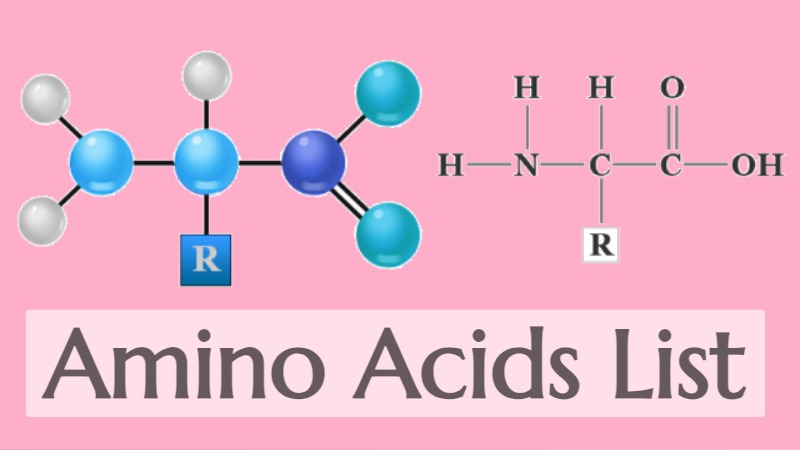
20 Amino Acids list with standard amino acid name, 3 letter code and 1 letter code, check list of twenty amino acids that are commonly found in proteins. These amino acids are the building blocks of proteins and are essential for various biological functions. Each amino acid has a unique chemical structure and plays a specific role in protein synthesis and function. The twenty standard amino acids differ in their side chain structures, which confer unique properties and functions to the proteins in which they are incorporated.
The twenty amino acids (that make up proteins) each have assigned to them both three-letter (can be upper or lower case) and one-letter codes (upper case). This makes it quicker and easier for notation purposes and are worth learning. The following list gives these notations along with hypertext references to download amino acid gif images and also interactive molecules.
You can now check functions of amino acids, classification of amino acids and other aspects regarding the amino acids.
Twenty Amino Acids List (Standard)
| Amino Acid Name | 3 Letter Code | 1 Letter Code |
|---|---|---|
| Alanine | Ala | A |
| Arginine | Arg | R |
| Asparagine | Asn | N |
| Aspartic acid | Asp | D |
| Cysteine | Cys | C |
| Glutamine | Gln | Q |
| Glutamic acid | Glu | E |
| Glycine | Gly | G |
| Histidine | His | H |
| Isoleucine | Ile | I |
| Leucine | Leu | L |
| Lysine | Lys | K |
| Methionine | Met | M |
| Phenylalanine | Phe | F |
| Proline | Pro | P |
| Serine | Ser | S |
| Threonine | Thr | T |
| Tryptophan | Trp | W |
| Tyrosine | Tyr | Y |
| Valine | Val | V |
Special Amino Acids
Sometimes it is not possible two differentiate two closely related amino acids, therefore we have the special cases:
| Amino Acid Name | 3 Letter Code | 1 Letter Code |
|---|---|---|
| Asparagine/aspartic acid | Asx | B |
| Glutamine/glutamic acid | Glx | Z |
Classification of Amino Acids
There are 20 standard amino acids commonly found in proteins, and they can be broadly categorized into several groups:-
- Aliphatic – alanine, glycine, isoleucine, leucine, proline, valine
- Aromatic – phenylalanine, tryptophan, tyrosine
- Acidic – aspartic acid, glutamic acid
- Basic – arginine, histidine, lysine
- Hydroxylic – serine, threonine
- Sulphur-containing – cysteine, methionine
- Amidic (containing amide group) – asparagine, glutamine
Functions of Amino Acids
Amino acids play essential roles in various biological processes, and their functions can be broadly categorized into the following areas:-
- Protein Synthesis: Amino acids are the building blocks of proteins. They are linked together in specific sequences during the process of protein synthesis, creating a wide range of proteins that perform various functions in the body.
- Enzyme Activity: Many enzymes are proteins that catalyze chemical reactions in the body. Amino acids within the enzyme’s active site are crucial for facilitating and speeding up these reactions.
- Cell Signaling: Some amino acids act as signaling molecules in cell communication pathways. For example, neurotransmitters in the nervous system, such as glutamate and gamma-aminobutyric acid (GABA), are amino acids that transmit signals between nerve cells.
- Structural Support: Amino acids contribute to the structural integrity of various tissues and organs.
Amino acids are organic compounds that serve as the building blocks of proteins. They are composed of an amino group (-NH2), a carboxyl group (-COOH), a hydrogen atom, and a side chain (R group), all attached to a central carbon atom. The classification of amino acids is based on the characteristics of their R groups.










